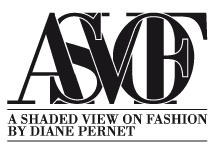Dear Shaded Viewers,
If you follow this site you are no doubt familiar with the work of Miguel Villalobos, a true Renaissance man. Miguel is teaching classes at Parsons School of Design in New York City and after instructing the students on the “Body” as a new “Form” and teaching about the construction of a garment aka “Shape” he gave them the assignment of interpreting the “Shape” for a conventional “Form or Figure” as the final stage of their project. Below, please find some of the students work. Perhaps more is coming…
Hanyong Yang
The name of my project is “Alone w/ Freedom”, which is my feeling in New York – I can be as wild as I can, but nobody really cares and I ultimately feel both happy and exhausted with the freedom.
I see people through the society. Regardless of their natural born feature, bodies function as the most common and important prop of our mind, our soul for performance – a real life performance – and that’s why people invent a variety of clothes and do a variety of modifications. That’s the reason I made the body expressive and was inspired by cubism, which shows how one things looks different from different perspectives. The reasonable dissembling of things also matches the loneliness.
The clothes for the body were inspired by the Studio 54 exhibition. When people in there just wear to gain happiness, show their bodies and personality – not caring the right or wrongs, that’s real freedom and pleasure like flying.

Phoebe Clark
Maxwell Sobieski
In the exploration of the body and how its proportions can be altered to bizarre and magnificent lengths, I focused on the machine-like quality of the body’s movements. With the help of professor Miguel, I looked into the work of Italian futurists and Russian constructivists such as Umberto Boccioni and Naum Gabo, Who utilized geometric forms to express movement in the angular qualities of joints and patterns of motion. Thus I set out to create a form constructed out of triangles, which I painted lacquer black. I immediately connected this large scale sharpness with Edo period Japanese tailoring seen in Kabuki theater, and the padding that fencers wear, which transforms the body into a machine. I looked at the history of both and the things that connected with them, and decided to create a garment that expressed these qualities. I choose to use the colors of black gold and silver to mimic the reserved beauty of Japanese lacquer. With this strict color palette concocted an ensemble out of gold lamé, Black moire silk, and aluminum. Mind it that the headpiece was from a previous project but I felt that it would fit into the narrative, about The relationship between Machine and nature, and Japanese history. I derived the form of the trousers from Hamaka pants worn by Japanese samurai that would ride on horseback. I changed the style to be able to be worn by multiple sizes with an adjustable tie closure, and eliminated additional pleating Found in antique examples down to four. The top garment is constructed out of gold Lamé which I felt resembled the texture of tree bark in the structure of paper lanterns. I cut large triangles out of this fabric and connected them together through folding and stitching. The final product was an ensemble that was rooted in the motifs that show up in my work, And a deeper understanding between the relationship of simple geometric forms and the body.

Miguel Villalobos
https://www.instagram.com/miguelvillalobosnyc/
https://www.cristinagrajalesinc.com/artists/tabor-villalobos
Later,
Diane








